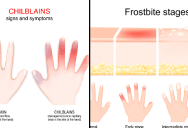Knowing The Differences Between Chilblains And Frostbite Could Save Your Fingers
The cold, like the heat, can be dangerous when the temperatures are extreme and exposure times are too long. You might have heard the terms “chilblains” and “frostbite,” but if you don’t live or visit climates where either is a serious risk, you might assume they’re interchangeable.
It turns out they’re not, and here are some ways you can tell them apart.
Both are the result of being out in the extreme cold for too long, but there are a few key differences when it comes to why each condition occurs.

Image Credit: iStock
Frostbite sets in when our blood vessels get cold enough to constrict, reducing blood flow first to the extremities – it’s basically the result of your body trying to keep your vital organs warm and full of oxygen so you don’t die.
Fingers, toes, noses, and the like are expendable, after all.

Image Credit: iStock
If you stay out long enough, the water in those tissues will actually freeze, which is when the Cleveland Clinic says you really need to worry.
“Frostbite begins with mild symptoms but quickly becomes a serious health risk the longer your skin freezes from exposure.
There are three stages of frostbite…in the second stage, your skin might feel warm, but the water in your skin is slowly freezing into ice crystals.”
The cause behind chilblains is less clear, though it has been linked to other diseases like lupus, erythromelalgia, and even COVID-19.
The leading theory, according to the Mayo Clinic, is that it’s more a reaction to warming up than getting cold.
“Rewarming of cold skin can cause small blood vessels under the skin to expand more quickly than nearby larger blood vessels can handle.
This results in a bottleneck effect and the blood leaking into nearby tissues.”
Chilblains also occurs at temperatures above freezing, as where frostbite only happens when the temperatures drop below.

image Credit: iStock
One easy way to tell the difference is that while frostbite occurs while you’re out in the elements, chilblains typically sets in a few hours after you come inside.
Another is the sensation that accompanies both – frostbite will feel like pins and needles in the affected area, at least at first. As things progress you might feel hard and frozen, then inexplicably warmer.
Chilblains is more of a red, itchy, or sometimes burning sensation on the surface of your skin.
More serious occurrences could also be accompanied by blisters or skin ulcers.

Image Credit: iStock
Your skin might turn red or a deep blue, whereas with frostbite it could be white or gray, then eventually black as the tissue freezes and dies.
Mild cases of both are very similar and hard to distinguish, and experts say mild frostbite can even lead to chilblains as you warm up.
The biggest differences is in the treatment and recovery.
Chilblains typically clears up on its own within a couple of weeks, according to Mayo.
“Chilblains usually clear up within one to three weeks, especially if the weather gets warmer. You may have recurrences seasonally for years…but chilblains don’t usually result in permanent injury.”
Anything more serious than mild frostbite, though, is going to require a medical professional.

Image Credit: iStock
“For all other frostbite, after appropriate first aid and assessment for hypothermia, medical treatment may involve rewarming, medications, wound care, surgery, and various therapies, depending on the severity of the injury.”
According to the NHS, the effects of frostbite can plague you years down the line, too.
“People with a history of severe frostbite often report further long-term effects. These can include: increased sensitivity to cold; numbness in the affected body parts, most commonly the fingers; and persistent pain in the affected body parts.”

Image Credit: iStock
Experts also urge to remember that pets can also get frostbite, so keep them in out of the cold or with access to proper food and shelter while they’re out.
The best thing to do for animals and humans alike is to avoid getting either condition in the first place, so make sure you’re properly dressed for the elements, listen to your body, and come in from the cold when it tells you it’s time.

Sign up to get our BEST stories of the week straight to your inbox.




